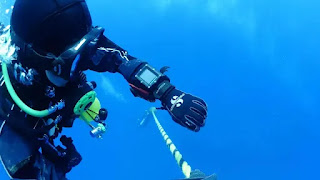INSTRUCTEUR EXAM A BALI
Un examen d’instructeur SSI (Scuba Schools
International) à Bali suit un processus standardisé par SSI, mais bénéficie
souvent du cadre idyllique et des excellentes conditions de plongée locales. Voici comment cela
se passe généralement :
🔹 Prérequis pour participer à l’examen
Avant l’examen proprement dit, le candidat doit :
- Avoir complété le SSI Instructor Training
Course (ITC), généralement sur 10 à 14 jours.
- Être Divemaster certifié, avec un
minimum de 75 plongées enregistrées (100 au moment de la
certification).
- Avoir les certifications en premiers secours
(React Right ou équivalent) à jour.
- Posséder un certificat médical de moins de 12
mois.
🔹 Structure de l’examen d’instructeur SSI (Instructor
Evaluation – IE)
L'examen dure en général 2 jours et est
supervisé par un Instructor Trainer certifié SSI, parfois envoyé depuis
l'étranger.
1. Épreuves théoriques
- Examens écrits : 50 questions sur les thèmes suivants :cours ITC Standards et procedures
- Évaluation des standards SSI : connaissance des standards, procédures et
outils pédagogiques.
2. Évaluation de la pédagogie
- Présentation académique : un exposé en salle devant d'autres
candidats, sur un thème attribué (ex : "effet de la pression sur les
gaz").peut etre sur les cours : open water, rescue, nitrox, dive
guide ou science de la plongee
- Présentation en milieu protégé (piscine) : démonstration de compétences et gestion de
scénarios. 1 exercices a demontrer et 2 eleves a corriger
- Présentation en milieu naturel (mer) : encadrement d'élèves dans des conditions
réelles, gestion de problème/sauvetage, etc. 2 exercices sans
demonstrations et 2 eleves a corriger
3. Compétences de démonstration
- Exécution et démonstration claire de
compétences clés (ex : vidage de masque, remontée d’urgence contrôlée). 3
exercices issus du skill circuit a demontrer avec qualite d’instructeur (
lent, exageration, sub skills
- Évaluation de la capacité à gérer des élèves
débutants et des problèmes sous l’eau.
🔹 Conditions
spécifiques à Bali
- Sites typiques : Tulamben
(épave USAT Liberty), Amed, Padang Bai ou Pemuteran (Menjangan).
- Langues : souvent possible en anglais, indonésien, ou français selon les
centres.
- Centres
populaires : Ocean Dreams Pemuteran, Blue Season Bali, Bali Diving Academy,
Dive Concepts, etc.
🔹 Coût approximatif
- ITC et IE : environ 37’000’000 inr ( juin 2025)
- TOUT INCLUS CHEZ OCEAN DREAMS PEMUTERAN(
material physique, digital, certification , cours et exam
Des questions ?
contactez-nous a info@oceandrreams.asia







